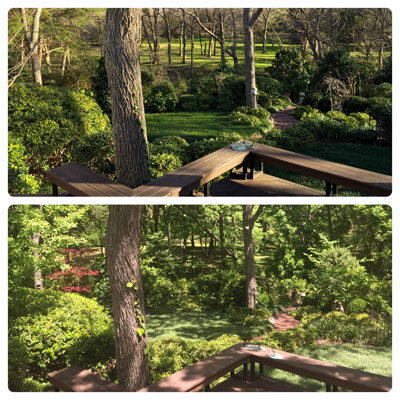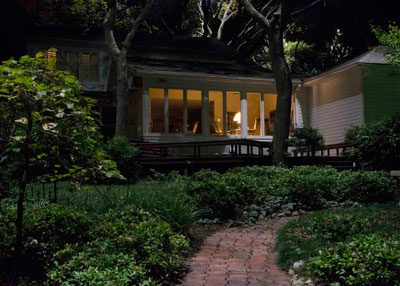The Sperry Backyard
Once in a while I post a photo taken from our sunroom windows. We live in rural Collin County (very alkaline soil), and we positioned our house 40 years ago to take advantage of the view. There are many much prettier garden designs across Texas, but this one serves us well, and it’s quickly available to me for photos. It also showcases most of my favorite shade-loving plants.
When I posted these two photos on Facebook a few days ago, I told folks that I’d include them in tonight’s e-gardens, along with an identification of as many of the plants as I could. I believe it will be easier for you to see definition in the winter photo (top), so I’ll use it.

Top photo was taken in late February, while the bottom photo was taken just a few days ago. Two months. Big changes. Click for a larger photo.
Here is your guide to a walk through our backyard.
• In the distance you see a planting of eastern redcedar junipers. They’re native to our property, so when I needed a screen to shield us from the neighbors, I planted about 20 of them in totally random arrangements. I chose 15-inch seedlings because they transplant so much more easily and successfully. I watered them by hand every five days their first two summers and never again since. They are now 25 feet tall and present a solid screen. Fastest choice we have.
• That is annual ryegrass on the hillside. Because it is so shaded all summer, no other grass grows there. I water it the day that it’s planted and maybe one more time a few days later. From that point on, it’s on its own. It will start thinning out in the next several weeks. In more manicured landscape settings, perennial ryegrass is a far better choice. It’s finer-bladed and more easily maintained. However, it’s not perennial in Texas. It transitions out in May.
• In the close-in part of the yard on our side of the creek, on the left you see a native redcedar that has been there all 46 years that we’ve owned the property. (We built 40 years ago.)
• Beneath the redcedar, with a splotch of sunlight beaming onto it, is a planting of dwarf Burford holly that is 35 years old and 7 feet tall.
• For this one moment, looking at the spring photo from last week, just above that dwarf Burford holly is a Bloodgood Japanese maple that has leafed out since the winter photo was taken. There are actually 8 or 10 of them scattered around this part of our total-shade landscape. They are great little accent trees for the shade.
• Behind the most conspicuous pecan trunk, you see a tree-form yaupon holly. I don’t recall the variety, but it is one selected to stay more compact.
• The shorter shrubs alongside the brick paver walk are Carissa dwarf hollies. They almost never need any trimming, and after 20 years they’re approximately 28 inches tall.
• In front of the second largest pecan trunk (more visible in the winter photo) is a post with a ceramic church atop it. Those are Carissa hollies at its base as well.
• The hollies behind that same pecan trunk with the church garden art are Needlepoint hollies (also known as Willowleaf holly) It’s my go-to holly if I need something 7 or 8 feet tall without a lot of trimming. I’m actually keeping these at 6 feet with one trimming in late February, before new growth begins. This photo was taken days after that trimming.
• The mid-sized shrubs to the right of the second largest pecan trunk are Little Red hollies. Behind them are a couple of Mary Nell hollies. Yes, I’m a holly fanatic, and I hope you can see why with all this variety.
• The tallest evergreen toward the right side of the photo is a specimen Nellie R. Stevens holly. It’s my favorite tall screening plant. This one has grown to be 12 or 14 feet tall. I have room for it to grow as tall as it wishes. I’ll probably eventually “limb it up” and train it tree-form, but we’ll see.
• The small shrubs in the lower right of the winter photo, topped with a bit of winter sun, are more Carissa hollies. (I used them to tie the garden together visually.) I also have giant liriope in that area.
• That’s a Traveler weeping redbud behind the Carissas (much more visible in winter photo), and behind it is an Oakleaf hydrangea. It’s almost invisible in the winter photo since its stems are bare. It’s my favorite flowering shrub for our shade garden. I’ve planted probably 25 of them in our woods.
• Just behind the Traveler redbud, and showing just a glow of sunlight in the winter photo, I’ve used Wintergreen Japanese boxwood. I trim it once each February to maintain it at 36 inches. I’ve used a lot of dwarf yaupons that aren’t visible in this particular part of our garden. Japanese boxwood gives a similar texture on a somewhat more upright shrub. The variety Wintergreen holds that color all winter.
• You can see only half of it, but in the middle on the right side of my photo is a rare large holly called Lusterleaf holly. Its leaves are as large as my palms and fingers. It’s difficult to find and slow-growing, but a handsome plant nonetheless.
• The groundcover in the foreground of both photos is regular mondograss (Ophiopogon). It’s a quick cover, and pecan leaves are easily blown out of it. I propagate my own for additional shade beds – we are all about shade in our forest.
• What you can’t see in these photos are several hundred aspidistras tucked away into corners. You also don’t see our several Umpqua Warrior nandinas for winter color, or the American beautyberries for late fall color. There is a Coralbark maple that extends in from the right side, but it really doesn’t show much. And a Warren’s Red possumhaw holly that’s just to the left of this viewpoint.
I’m now deciding that a video would be a better option, and I’ll try to get that done over the next weeks or months. With our granddaughter’s successful cleft palate surgery this past Monday, I’m just kinda behind the curve for this week.
Hope you enjoyed this. If nothing else, maybe it will give you hope for your shade garden where the grass just won’t grow. And maybe it will help you begin your own shopping list.

Just to offer a different perspective, this is what our landscape looks like at night. Those are the windows from which I took the other photos. Lighting by Lentz Landscape Lighting, Dallas. Click for a larger photo.
